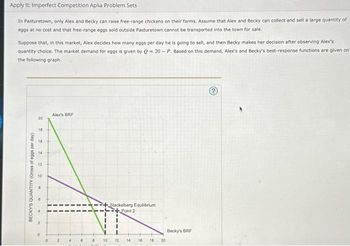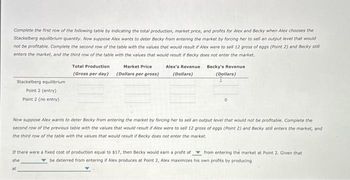
ENGR.ECONOMIC ANALYSIS
14th Edition
ISBN: 9780190931919
Author: NEWNAN
Publisher: Oxford University Press
expand_more
expand_more
format_list_bulleted
Question
Note:-
- Do not provide handwritten solution. Maintain accuracy and quality in your answer. Take care of plagiarism.
- Answer completely.
- You will get up vote for sure.

Transcribed Image Text:Apply It: Imperfect Competition Aplia Problem Sets
In Pasturetown, only Alex and Becky can raise free-range chickens on their farms. Assume that Alex and Becky can collect and sell a large quantity of
eggs at no cost and that free-range eggs sold outside Pasturetown cannot be transported into the town for sale.
Suppose that, in this market, Alex decides how many eggs per day he is going to sell, and then Becky makes her decision after observing Alex's
quantity choice. The market demand for eggs is given by Q=20-P. Based on this demand, Alex's and Becky's best-response functions are given on
the following graph.
BECKY'S QUANTITY (Gross of eggs per day)
20
18
10
6
N
Alex's BRF
Stackelberg Equilibrium
+Point 2
10 12 14 16
18
20
Becky's BRF
?

Transcribed Image Text:Complete the first row of the following table by indicating the total production, market price, and profits for Alex and Becky when Alex chooses the
Stackelberg equilibrium quantity. Now suppose Alex wants to deter Becky from entering the market by forcing her to sell an output level that would
not be profitable. Complete the second row of the table with the values that would result if Alex were to sell 12 gross of eggs (Point 2) and Becky still
enters the market, and the third row of the table with the values that would result if Becky does not enter the market.
Becky's Revenue
(Dollars)
Stackelberg equilibrium
Point 2 (entry)
Point 2 (no entry)
Total Production
(Gross per day)
Market Price
(Dollars per gross)
Alex's Revenue
(Dollars)
Now suppose Alex wants to deter Becky from entering the market by forcing her to sell an output level that would not be profitable. Complete the
second row of the previous table with the values that would result if Alex were to sell 12 gross of eggs (Point 2) and Becky still enters the market, and
the third row of the table with the values that would result if Becky does not enter the market.
If there were a fixed cost of production equal to $17, then Becky would earn a profit of from entering the market at Point 2. Given that
she
be deterred from entering if Alex produces at Point 2, Alex maximizes his own profits by producing
at
Expert Solution
This question has been solved!
Explore an expertly crafted, step-by-step solution for a thorough understanding of key concepts.
Step by stepSolved in 4 steps

Knowledge Booster
Learn more about
Need a deep-dive on the concept behind this application? Look no further. Learn more about this topic, economics and related others by exploring similar questions and additional content below.Similar questions
- Note:- Do not provide handwritten solution. Maintain accuracy and quality in your answer. Take care of plagiarism.Answer completely.You will get up vote for sure.arrow_forwardNote:- Do not provide handwritten solution. Maintain accuracy and quality in your answer. Take care of plagiarism. Answer completely. You will get up vote for sure.arrow_forwardNote:- Do not provide handwritten solution. Maintain accuracy and quality in your answer. Take care of plagiarism. Answer completely. You will get up vote for sure.arrow_forward
- Note:- Do not provide handwritten solution. Maintain accuracy and quality in your answer. Take care of plagiarism.Answer completely.You will get up vote for sure.arrow_forwardAccordingtothetextbook,whichofthefollowingstatementsis(are)correct? (x) When a taxpayer attempts to legally reduce her tax liability, she is engaging in “tax evasion” and when an individual fraudulently avoids paying taxing, she is engaging in “tax avoidance”. (y) One tax system is considered more efficient than another if it raises the same amount of tax revenue at a lower cost to taxpayers. (z) Part of the administrative burden of a tax is associated with the headache of filling out tax forms imposed on taxpayers who comply with the tax. (x), (y) and (z) (x) and (y) only (x) and (z) only (y) and (z) only (x) onlyarrow_forwardwhat are the numbers that go in the cost table A through L Note:- Do not provide handwritten solution. Maintain accuracy and quality in your answer. Take care of plagiarism. Answer completely. You will get up vote for sure.arrow_forward
- An investor is considering the following two investments.•Investment 1 has an expected rate of return (profit) of 8% and costs $40 per share.•Investment 2 has an expected rate of return (profit) of 5% and costs $30 per share.The investor has $100 to invest to maximize her total expected rate of return, and shemust buy whole shares (not partial/factional shares) of the investments.(a) Formulate the investor’s integer programming problem.(b) Solve the investor’s problem using branch and bound and explain youranswer. How much of each investment does the investor purchase?arrow_forwardNote:- Do not provide handwritten solution. Maintain accuracy and quality in your answer. Take care of plagiarism. Answer completely. You will get up vote for sure.arrow_forwardA doctor's office staff studied the waiting times for patients who arrive at the office with a request for emergency service. The following data with waiting times in minutes were collected over a one- month period. a. Fill in the frequency values below. Waiting Time Frequency 49 11 16 4 2 3 18 11 7 9 8 12 24 7 8 7 13 19 5 4 0-4 5-9 8 4 10-14 15-19 3 20-24 1 Total 20 b. Fill in the relative frequency (2 decimals) values below. Waiting Time Relative Frequency 0.2 0-4 5-9 0.4 0.2 10-14 15-19 0.15 20-24 0.05 Total 1arrow_forward
- Note:- Do not provide handwritten solution. Maintain accuracy and quality in your answer. Take care of plagiarism. Answer completely. You will get up vote for sure.arrow_forwardNote:- Do not provide handwritten solution. Maintain accuracy and quality in your answer. Take care of plagiarism. Answer completely. You will get up vote for sure.arrow_forwardRevenue and Costs ($) TC P61 Given TFC = $40.00 Q1 = 30.00 Q2 = 40.00 TR P6 P5 Q3 = 50.00 Q4 = 80.00 Q5 = 86.00 P4. P1 = $40.00 P2 = $50.00 P3 = $60.0o P4 = $150.00 P5 = $200.00 P6 = $210.00 P61 = $320.00 P3 P2 P1 Q1 Q2 Q4 Q5 Q3 Exhibit TR-TC Output (Q) Refer to Exhibit TR-TC for a typical competitive firm. At an output level of Q5, the firm's losses is about O $100.00 O $90.00 O $110.00 O $120.00arrow_forward
arrow_back_ios
SEE MORE QUESTIONS
arrow_forward_ios
Recommended textbooks for you

 Principles of Economics (12th Edition)EconomicsISBN:9780134078779Author:Karl E. Case, Ray C. Fair, Sharon E. OsterPublisher:PEARSON
Principles of Economics (12th Edition)EconomicsISBN:9780134078779Author:Karl E. Case, Ray C. Fair, Sharon E. OsterPublisher:PEARSON Engineering Economy (17th Edition)EconomicsISBN:9780134870069Author:William G. Sullivan, Elin M. Wicks, C. Patrick KoellingPublisher:PEARSON
Engineering Economy (17th Edition)EconomicsISBN:9780134870069Author:William G. Sullivan, Elin M. Wicks, C. Patrick KoellingPublisher:PEARSON Principles of Economics (MindTap Course List)EconomicsISBN:9781305585126Author:N. Gregory MankiwPublisher:Cengage Learning
Principles of Economics (MindTap Course List)EconomicsISBN:9781305585126Author:N. Gregory MankiwPublisher:Cengage Learning Managerial Economics: A Problem Solving ApproachEconomicsISBN:9781337106665Author:Luke M. Froeb, Brian T. McCann, Michael R. Ward, Mike ShorPublisher:Cengage Learning
Managerial Economics: A Problem Solving ApproachEconomicsISBN:9781337106665Author:Luke M. Froeb, Brian T. McCann, Michael R. Ward, Mike ShorPublisher:Cengage Learning Managerial Economics & Business Strategy (Mcgraw-...EconomicsISBN:9781259290619Author:Michael Baye, Jeff PrincePublisher:McGraw-Hill Education
Managerial Economics & Business Strategy (Mcgraw-...EconomicsISBN:9781259290619Author:Michael Baye, Jeff PrincePublisher:McGraw-Hill Education


Principles of Economics (12th Edition)
Economics
ISBN:9780134078779
Author:Karl E. Case, Ray C. Fair, Sharon E. Oster
Publisher:PEARSON

Engineering Economy (17th Edition)
Economics
ISBN:9780134870069
Author:William G. Sullivan, Elin M. Wicks, C. Patrick Koelling
Publisher:PEARSON

Principles of Economics (MindTap Course List)
Economics
ISBN:9781305585126
Author:N. Gregory Mankiw
Publisher:Cengage Learning

Managerial Economics: A Problem Solving Approach
Economics
ISBN:9781337106665
Author:Luke M. Froeb, Brian T. McCann, Michael R. Ward, Mike Shor
Publisher:Cengage Learning

Managerial Economics & Business Strategy (Mcgraw-...
Economics
ISBN:9781259290619
Author:Michael Baye, Jeff Prince
Publisher:McGraw-Hill Education